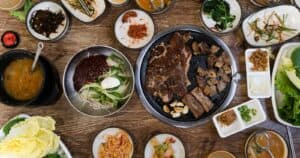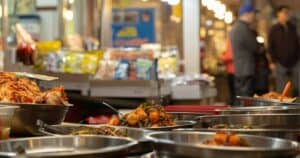Are you curious to know if every single Korean consumes kimchi on a daily basis? Well, the truth might surprise you! While kimchi is undoubtedly a beloved staple in Korean cuisine, not all Koreans eat it every day. So, let’s dive into the fascinating world of Korean dietary habits and discover the real facts behind kimchi consumption.
In reality, around 3.6% of Koreans surveyed stated that they didn’t eat kimchi at all. However, a majority of respondents reported enjoying this iconic dish daily, highlighting its significance in Korean culture.
With 95% of Koreans consuming kimchi, amounting to a staggering 2 million tons annually, it’s safe to say that this fermented delight holds a special place in the hearts (and stomachs!) of many Koreans.
The Significance of Kimchi in Korean Culture
Kimchi holds immense cultural importance in Korean culture, symbolizing the country’s identity and pride. It has been an integral part of Korean food culture for thousands of years, consumed daily and served at almost every meal. In fact, the practice of making and sharing kimchi, known as Kimjang, was even recognized by UNESCO as an Intangible Cultural Heritage of Humanity.
Kimchi’s significance goes beyond just being a staple food. It has deep historical roots and reflects the Korean way of life, embodying ancient values. Kimjang, which involves families coming together to prepare kimchi, not only strengthens family bonds but also serves as a reminder of the importance of living in harmony with nature.
Housewives monitor weather forecasts to determine the best conditions for kimchi preparation, highlighting the connection to nature.
Moreover, kimchi plays a role in promoting Korean culture and cuisine worldwide, serving as a symbol of South Korea’s “soft power.” It has a global influence and is used to connect with people from different countries. Overall, kimchi is not just a food but a representation of tradition, identity, and pride, making it an integral part of Korean cultural heritage.
Kimchi Consumption Statistics: Do All Koreans Eat It Every Day?
- According to a survey conducted in South Korea in March 2019, only 3.6% of respondents reported eating kimchi every day.
- The cultural heritage administration in Seoul states that about 95% of Koreans eat kimchi more than once a day.
- On average, Koreans consume 37 kilograms of kimchi every year.
- Kimchi is a staple food in Korean cuisine and is consumed daily by a significant portion of the population.
- However, the frequency of kimchi consumption can vary among individuals, depending on personal preferences and dietary habits.
- Fresh vegetable kimchi showed the highest consumption frequency, while other types of kimchi were consumed less than once a day.
- Overall, while kimchi is widely consumed in Korea, not all Koreans eat it every day.
Exploring the Variety of Korean Cuisine Beyond Kimchi
Korean cuisine offers a plethora of mouth-watering dishes beyond the well-known kimchi. From sizzling Korean BBQ and comforting bibimbap to crispy jeon pancakes and hearty doenjang jjigae soup, there is something to satisfy every palate. Let’s take a closer look at these delightful culinary creations:
Korean BBQ: A favorite dining style, Korean BBQ allows diners to grill their own meat at the table. With a variety of condiments and side dishes, it’s an interactive and flavorsome experience.
Bibimbap: This colorful dish features a delectable combination of white rice and stir-fried vegetables. Mixed together with a spicy sauce, it creates a harmonious blend of flavors and textures.
Jeon: Craving something crispy? Look no further than jeon, a savory Korean pancake made with a batter of flour, eggs, and water. Pan-fried with various ingredients like vegetables, seafood, or meat, it’s a delightful snack or appetizer.
Doenjang jjigae: For a hearty and comforting soup, don’t miss out on doenjang jjigae. Made with fermented soybean paste, pork, tofu, and an array of vegetables, it offers a rich and savory taste that’s hard to resist.
Fried chicken: Korean fried chicken is renowned for its crispy coating and delectable sauce. Whether you prefer a sweet and sticky sauce or a fiery and spicy one, this dish is sure to satisfy your cravings.
These examples merely scratch the surface of the vast array of Korean cuisine. With their rich flavors, diverse textures, and unique ingredients, Korean dishes extend far beyond kimchi. So, venture beyond the familiar and discover the true depth and variety of Korean gastronomy.
Exquisite Korean Barbecue: A Must-Try Dining Experience
Korean barbecue is a must-try dining experience that offers a variety of delicious dishes. From the well-known Bulgogi to the popular galbi and samgyeopsal, Korean BBQ restaurants offer a fun and interactive dining experience that has gained popularity worldwide.
One of the highlights of Korean barbecue is Bulgogi, a dish made with thinly sliced beef that has been marinated in a flavorful sauce. The marinade, which includes ingredients like sugar, sesame oil, ginger, and a blend of spices, gives the meat a savory and sweet taste that is truly delightful.
Korean BBQ restaurants are favored for their unique dining style. Each table is equipped with a grill, allowing diners to cook their own meat right at the table. This interactive experience not only adds a layer of fun but also allows diners to tailor their cooking preferences to their own taste. Alongside the grilled meat, customers can enjoy various condiments and side dishes, making each bite a memorable one.
For those seeking a truly elevated Korean barbecue experience, there are Michelin-starred Korean BBQ establishments. These restaurants offer expertly sourced ingredients, refined ambiance, quality wine-lists, and precise attention to detail. It’s a chance to explore the art of Korean barbecue at its finest.
Mouthwatering Stews: Comfort Food for Koreans
Korean cuisine is famous for its comforting and delicious soups and stews. These mouthwatering stews are a staple in Korean households, providing warmth and satisfaction during colder months or when in need of a comforting meal. Let’s explore some popular Korean stews that are sure to tantalize your taste buds.
Kimchi Jjigae: This spicy and flavorful stew is made with fermented kimchi, pork, tofu, and various vegetables. The combination of tangy kimchi and savory ingredients creates a delicious explosion of flavors that will leave you craving for more.
Doenjang Jjigae: A hearty stew made with fermented soybean paste, vegetables, tofu, and often includes meat or seafood. This stew offers a deep umami flavor from the fermented soybean paste and a medley of vegetables, making it a perfect bowl of comfort.
Budae Jjigae (Army Stew): This unique stew originated during the Korean War and is made with a combination of ingredients like spam, hot dogs, instant noodles, kimchi, and various vegetables. Despite its unconventional ingredients, Budae Jjigae has gained popularity for its comforting and satisfying taste.
These stews are typically enjoyed with a bowl of rice and offer a range of flavors from spicy and bold to rich and comforting. They are deeply ingrained in Korean culture and are a go-to option for a heartwarming and satisfying meal.
Delectable Rice Dishes: A Staple in Korean Cuisine
Rice dishes are a staple in Korean cuisine, offering a variety of delectable options that showcase the versatility and flavors of Korean cooking. These dishes are enjoyed by Koreans worldwide and go beyond just kimchi. Let’s explore some of the popular rice dishes in Korean cuisine:
Bibimbap: This dish is a favorite among Koreans, consisting of a bowl of rice topped with sautéed and seasoned vegetables, meat (optional), and a fried egg. The dish is often served with gochujang, a spicy red pepper paste, adding a burst of flavor.
Fried Rice (Bokkeumbap): Fried rice is a versatile dish that can be made with various ingredients such as vegetables, meat, and seafood. The rice is seasoned with soy sauce and other seasonings, creating a savory and flavorful taste. It’s a quick and easy dish that is often enjoyed as a main course or side dish.
Kimchi Fried Rice (Kimchi Bokkeumbap): This dish is a spicy and tangy delight made with kimchi, rice, and often includes other ingredients like meat or vegetables. It’s a popular way to use leftover rice and adds a kick of flavor to the dish. Kimchi lovers will especially enjoy this flavorful rice dish.
Tuna Mayo Rice (Chamchi Mayo Bap): For those looking for a simple yet tasty option, this dish is made with canned tuna mixed with mayonnaise and served over a bed of rice. It’s a quick and easy option that is loved by many.
Unveiling Other Korean Staples: Noodles, Pancakes, and More
Korean cuisine is much more than just kimchi. Apart from the famous fermented dish, there are several other Korean staples that are worth exploring. Let’s uncover the delicious world of Korean noodles, pancakes, and more.
Noodles:
- Naengmyeon: A popular Korean cold noodle dish, usually served in a chilled broth and topped with vegetables, pickles, and sometimes sliced beef or seafood.
- Japchae: Stir-fried glass noodles made from sweet potato starch, mixed with various vegetables, and often seasoned with soy sauce and sesame oil.
- Ramyeon: Korean-style instant noodles that come in a variety of flavors and are a quick and convenient meal option.
Pancakes:
- Buchimgae: A general term for Korean pancakes that can be made with various ingredients, such as vegetables, seafood, or kimchi.
- Hotteok: A sweet pancake filled with a mixture of brown sugar, cinnamon, and chopped peanuts, often enjoyed as a street food snack.
- Gamjajeon: A potato pancake made with grated or sliced potatoes, mixed with flour and egg, and pan-fried until crispy.
Other Korean Staples:
- Bibimbap: A hearty rice dish topped with an assortment of seasoned vegetables, meat, and egg, often served with gochujang (chili pepper paste) on the side.
- Jjajangmyeon: Noodles topped with a thick black bean sauce, along with diced meat and vegetables, a popular comfort food in Korea.
- Tteokbokki: Spicy rice cakes cooked in a gochujang-based sauce, often combined with fish cakes, vegetables, and other ingredients to create a flavorful and satisfying dish.
Koreans enjoy a diverse range of dishes beyond kimchi, and these staples are widely appreciated for their unique flavors and textures. From savory pancakes to comforting noodles, Korean cuisine offers a variety of options that cater to different tastes and preferences. So, next time you explore Korean cuisine, don’t forget to try these delightful dishes alongside the iconic kimchi.
Regional Variations in Korean Dietary Habits
South Korea exhibits regional disparities in dietary habits and preferences, influenced by its diverse geography and cultural traditions. Let’s explore the variations in Korean dietary habits across different regions.
Regional Cuisines:
- The four regions of Korea (North, South, East, and West) have distinct local specialties and styles of cuisine. These regional cuisines have been preserved despite increased contact between regions.
- Varying geographical features and climates contribute to the development of unique culinary traditions, reflecting the local ingredients and culinary techniques.
Kimchi Consumption:
- Kimchi, a staple in Korean cuisine, is consumed at varying frequencies across different regions.
- About 95% of Koreans eat kimchi more than once a day, with over 60% having it for breakfast, lunch, and dinner in Seoul. However, there may be regional variations in the types and preferences for kimchi, with an estimated 100 varieties available throughout the country.
Nutrient Intake and Skipping Meals:
- Consumption of baechu kimchi (made from Chinese cabbage) is associated with lower rates of meal skipping among Korean adults. This suggests that kimchi consumption influences overall meal patterns.
- The inclusion of kimchi as a common side dish in Korean meals may contribute to a more balanced nutrient intake across different regions.





